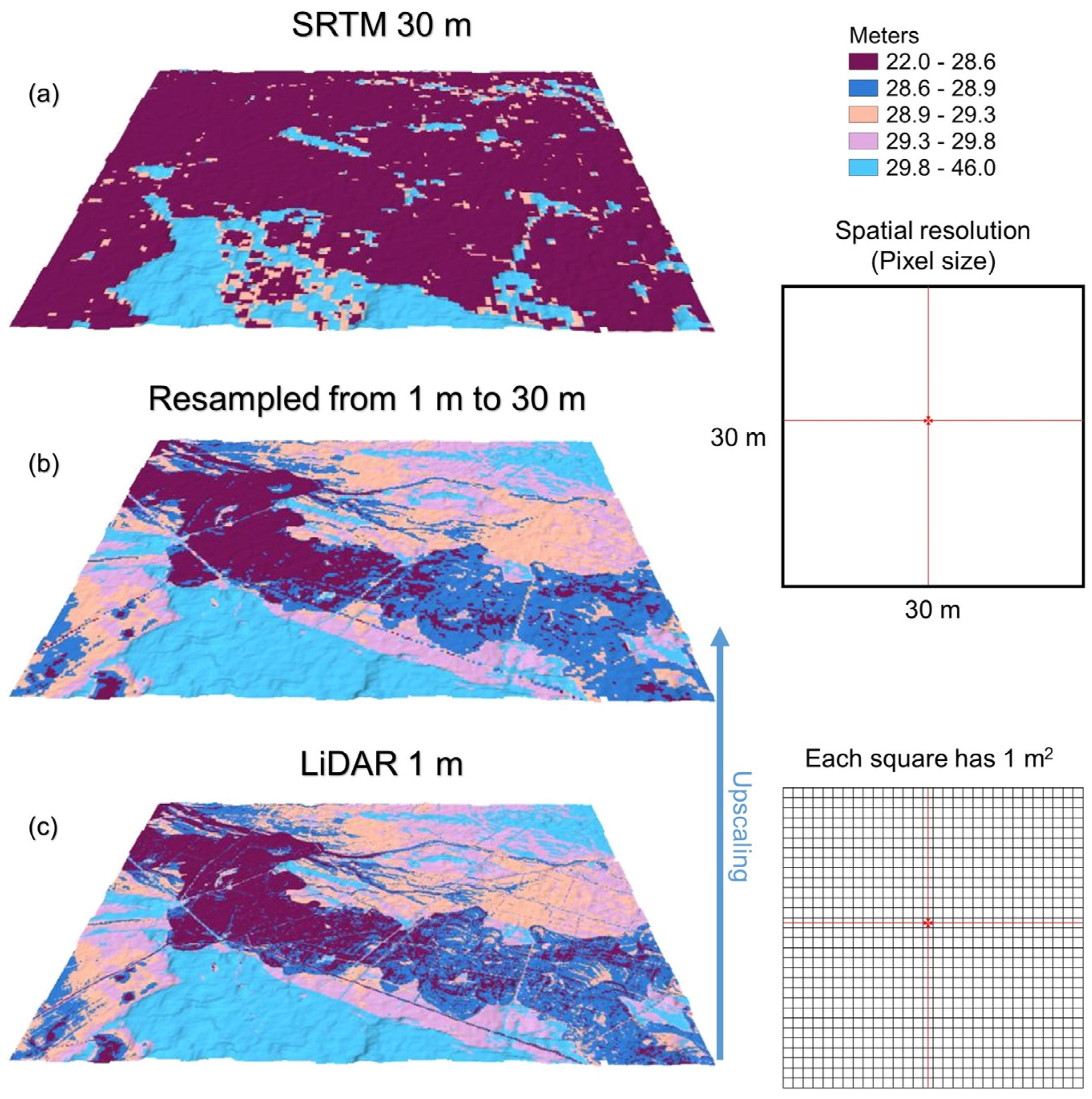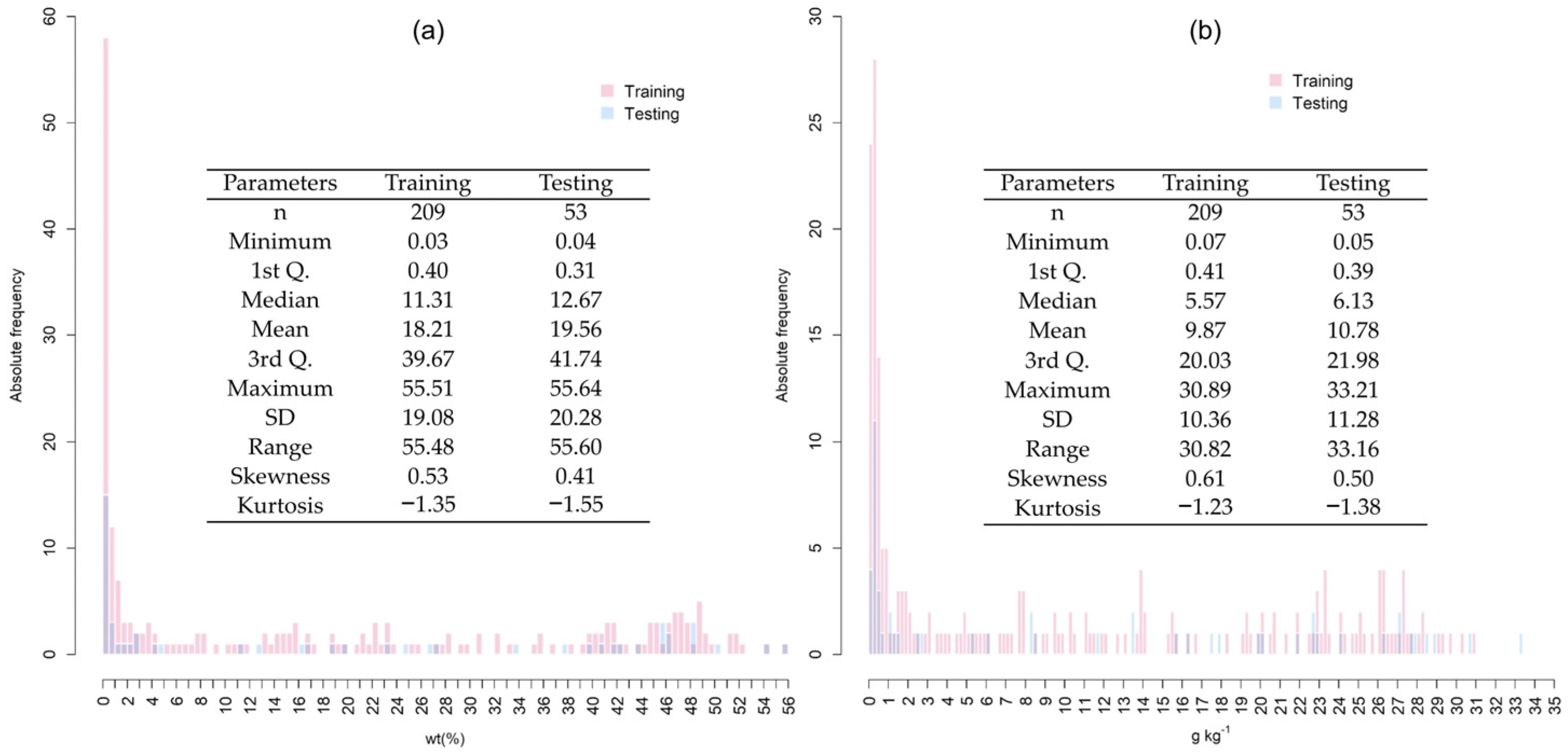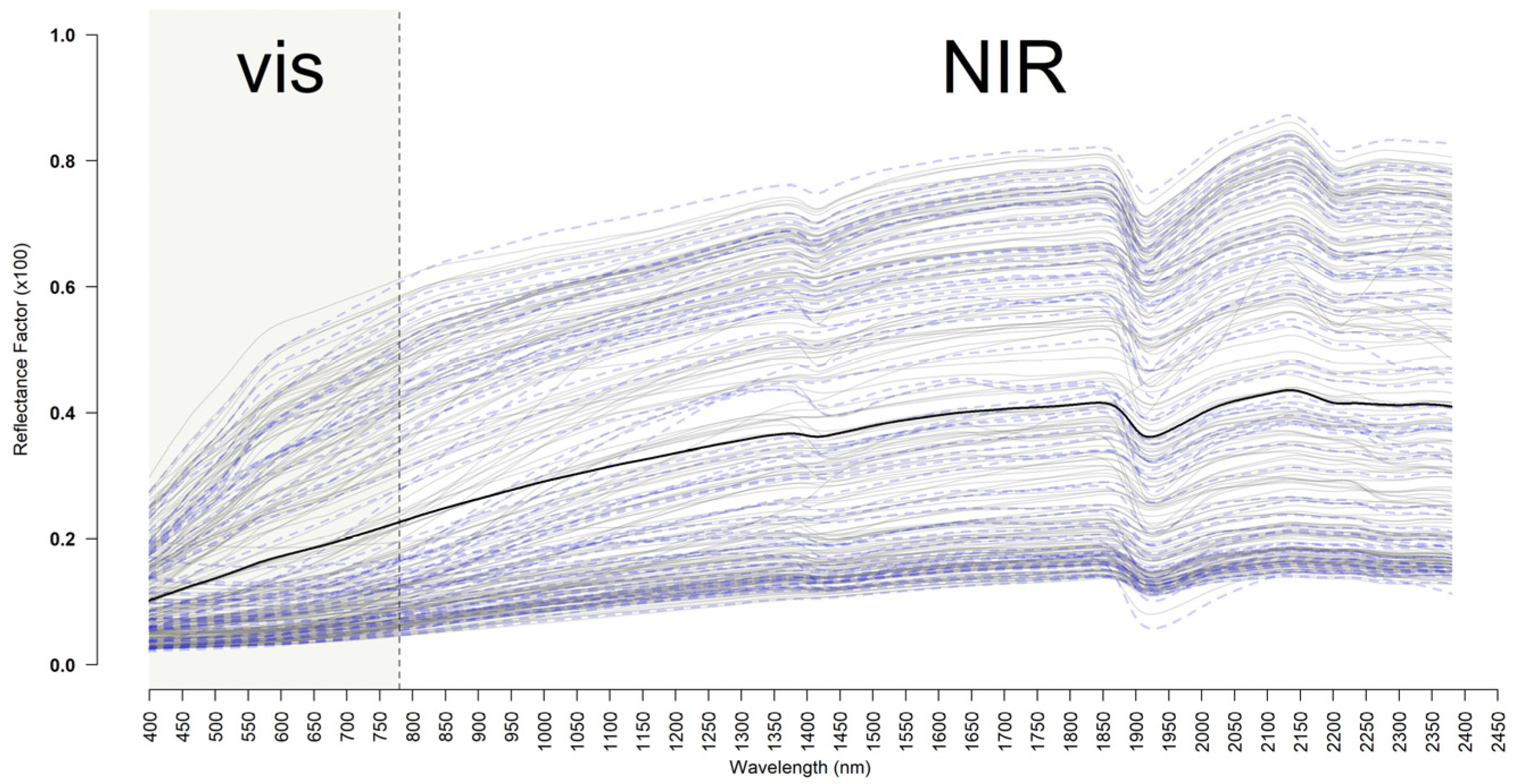Advancing Soil Organic Carbon and Total Nitrogen Modelling in Peatlands: The Impact of Environmental Variable Resolution and vis-NIR Spectroscopy Integration
Abstract
:1. Introduction
2. Materials and Methods
2.1. Study Area and Soil Samples
2.2. Conventional Laboratory Analysis of Soil Organic Carbon and Total Nitrogen
2.3. Visible and Near-Infrared Soil Spectral Library
2.4. Environmental Variables from Remote Sensing
2.5. Modelling Procedures and Model Assessment
3. Results
3.1. Exploratory Data Analysis of Soil Organic Carbon and Total Nitrogen
3.2. Relationship between vis-NIR Spectra and Soil Components
3.3. Effects of Environmental Variables on Model Prediction
4. Discussion
5. Conclusions
Author Contributions
Funding
Data Availability Statement
Acknowledgments
Conflicts of Interest
References
- Batjes, N.H. Total carbon and nitrogen in the soils of the world. Eur. J. Soil Sci. 1996, 47, 151–163. [Google Scholar] [CrossRef]
- Norse, D. Low carbon agriculture: Objectives and policy pathways. Environ. Dev. 2012, 1, 25–39. [Google Scholar] [CrossRef]
- McBratney, A.B.; Minasny, B.; Viscarra Rossel, R. Spectral soil analysis and inference systems: A powerful combination for solving the soil data crisis. Geoderma 2006, 136, 272–278. [Google Scholar] [CrossRef]
- Barra, I.; Haefele, S.M.; Sakrabani, R.; Kebede, F. Soil spectroscopy with the use of chemometrics, machine learning and pre-processing techniques in soil diagnosis: Recent advances–A review. TrAC—Trends Anal. Chem. 2021, 135, 116166. [Google Scholar] [CrossRef]
- Viscarra Rossel, R.A.; Behrens, T.; Ben-Dor, E.; Chabrillat, S.; Demattê, J.A.M.; Ge, Y.; Gomez, C.; Guerrero, C.; Peng, Y.; Ramirez-Lopez, L.; et al. Diffuse reflectance spectroscopy for estimating soil properties: A technology for the 21st century. Eur. J. Soil Sci. 2022, 73, e13271. [Google Scholar] [CrossRef]
- Shonk, J.L.; Gaultney, L.D.; Schulze, D.G.; Van Scoyoc, G.E. Spectroscopic Sensing of Soil Organic Matter Content. Trans. ASAE 1991, 34, 1978–1984. [Google Scholar] [CrossRef]
- Demattê, J.A.M.; Dotto, A.C.; Paiva, A.F.S.; Sato, M.V.; Dalmolin, R.S.D.; de Araújo, M.d.S.B.; da Silva, E.B.; Nanni, M.R.; ten Caten, A.; Noronha, N.C.; et al. The Brazilian Soil Spectral Library (BSSL): A general view, application and challenges. Geoderma 2019, 354, 113793. [Google Scholar] [CrossRef]
- Ng, W.; Minasny, B.; de Mendes, W.S.; Demattê, J.A.M. The influence of training sample size on the accuracy of deep learning models for the prediction of soil properties with near-infrared spectroscopy data. SOIL 2020, 6, 565–578. [Google Scholar] [CrossRef]
- Soriano-Disla, J.M.; Janik, L.J.; Viscarra Rossel, R.A.; Macdonald, L.M.; McLaughlin, M.J. The Performance of Visible, Near-, and Mid-Infrared Reflectance Spectroscopy for Prediction of Soil Physical, Chemical, and Biological Properties. Appl. Spectrosc. Rev. 2014, 49, 139–186. [Google Scholar] [CrossRef]
- Kuhn, M.; Quinlan, R. Cubist: Rule-and Instance-Based Regression Modeling. Available online: https://cran.r-project.org/web/packages/Cubist/index.html (accessed on 3 December 2020).
- Quinlan, J.R. C4.5; Elsevier: Amsterdam, The Netherlands, 1993; ISBN 9780080500584. [Google Scholar]
- Sabetizade, M.; Gorji, M.; Roudier, P.; Zolfaghari, A.A.; Keshavarzi, A. Combination of MIR spectroscopy and environmental covariates to predict soil organic carbon in a semi-arid region. Catena 2021, 196, 104844. [Google Scholar] [CrossRef]
- Guo, Z.; Adhikari, K.; Chellasamy, M.; Greve, M.B.; Owens, P.R.; Greve, M.H. Selection of terrain attributes and its scale dependency on soil organic carbon prediction. Geoderma 2019, 340, 303–312. [Google Scholar] [CrossRef]
- Gatis, N.; Luscombe, D.J.; Carless, D.; Parry, L.E.; Fyfe, R.M.; Harrod, T.R.; Brazier, R.E.; Anderson, K. Mapping upland peat depth using airborne radiometric and lidar survey data. Geoderma 2019, 335, 78–87. [Google Scholar] [CrossRef]
- Mulder, V.L.L.; De Bruin, S.; Schaepman, M.E.E.; Mayr, T.R.R. The use of remote sensing in soil and terrain mapping—A review. Geoderma 2011, 162, 1–19. [Google Scholar] [CrossRef]
- de Mendes, W.S.; Demattê, J.A.M.; Silvero, N.E.Q.; Rabelo Campos, L. Integration of multispectral and hyperspectral data to map magnetic susceptibility and soil attributes at depth: A novel framework. Geoderma 2021, 385, 114885. [Google Scholar] [CrossRef]
- Minasny, B.; Berglund, Ö.; Connolly, J.; Hedley, C.; de Vries, F.; Gimona, A.; Kempen, B.; Kidd, D.; Lilja, H.; Malone, B.; et al. Digital mapping of peatlands—A critical review. Earth-Sci. Rev. 2019, 196, 102870. [Google Scholar] [CrossRef]
- Koszinski, S.; Miller, B.A.; Hierold, W.; Haelbich, H.; Sommer, M. Spatial Modeling of Organic Carbon in Degraded Peatland Soils of Northeast Germany. Soil Sci. Soc. Am. J. 2015, 79, 1496–1508. [Google Scholar] [CrossRef]
- Vašát, R.; Kodešová, R.; Borůvka, L.; Jakšík, O.; Klement, A.; Brodský, L. Combining reflectance spectroscopy and the digital elevation model for soil oxidizable carbon estimation. Geoderma 2017, 303, 133–142. [Google Scholar] [CrossRef]
- Peng, Y.; Xiong, X.; Adhikari, K.; Knadel, M.; Grunwald, S.; Greve, M.H. Modeling soil organic carbon at regional scale by combining multi-spectral images with laboratory spectra. PLoS ONE 2015, 10, e0142295. [Google Scholar] [CrossRef] [PubMed] [Green Version]
- IUSS Working Group WRB. World Reference Base for Soil Resources 2014: International Soil Classification System for Naming Soils and Creating Legends for Soil Maps; FAO: Rome, Italy, 2015; ISBN 9789251083697. [Google Scholar]
- DIN ISO10694:1996-08; Bodenbeschaffenheit—Bestimmung von organischem Kohlenstoff und Gesamtkohlenstoff nach trockener Verbrennung (Elementaranalyse). Soil Quality—Determination of Organic and Total Carbon after Dry Combustion (Elementary Analysis); ISO: Berlin, Germany, 1996.
- DIN ISO 13878; Bodenbeschaffenheit—Bestimmung des Gesamt-Stickstoffs durch trockene Verbrennung (Elementaranalyse). Soil Quality e Determination of Total Nitrogen Content by Dry Combustion (Elemental Analysis); ISO: Berlin, Germany, 1998.
- Mendes, W.S.; Sommer, M.; Koszinski, S.; Wehrhan, M. Peatlands spectral data influence in global spectral modelling of soil organic carbon and total nitrogen using visible-near-infrared spectroscopy. J. Environ. Manage. 2022, 317, 115383. [Google Scholar] [CrossRef]
- USGS. USGS EROS Archive—Digital Elevation—Shuttle Radar Topography Mission (SRTM) 1 Arc-Second Global. Available online: https://www.usgs.gov/centers/eros/science/usgs-eros-archive-digital-elevation-shuttle-radar-topography-mission-srtm-1-arc?qt-science_center_objects=0#qt-science_center_objects (accessed on 29 May 2020).
- Weiss, A. Topographic position and landforms analysis. In ESRI Users Conference; The Nature Conservancy, Northwest Division: San Diego, CA, USA, 2001. [Google Scholar]
- Minasny, B.; McBratney, A.B. A conditioned Latin hypercube method for sampling in the presence of ancillary information. Comput. Geosci. 2006, 32, 1378–1388. [Google Scholar] [CrossRef]
- Roudier, P.; Hewitt, A.; Beaudette, D. A conditioned Latin hypercube sampling algorithm incorporating operational constraints. In Digital Soil Assessments and Beyond; CRC Press: Boca Raton, FL, USA, 2012; pp. 227–231. [Google Scholar]
- Kuhn, M. Building Predictive Models in R Using the caret Package. J. Stat. Softw. 2008, 28, 1–26. [Google Scholar] [CrossRef] [Green Version]
- Janssen, P.H.M.; Heuberger, P.S.C. Calibration of process-oriented models. Ecol. Modell. 1995, 83, 55–66. [Google Scholar] [CrossRef]
- Ben-Dor, E.; Banin, A. Visible and near-infrared (0.4–1.1 μm) analysis of arid and semiarid soils. Remote Sens. Environ. 1994, 48, 261–274. [Google Scholar] [CrossRef]
- Stoner, E.R.; Baumgardner, M.F. Characteristic Variations in Reflectance of Surface Soils. Soil Sci. Soc. Am. J. 1981, 45, 1161. [Google Scholar] [CrossRef] [Green Version]
- Clark, R.N.; King, T.V.V.; Klejwa, M.; Swayze, G.A.; Vergo, N. High spectral resolution reflectance spectroscopy of minerals. J. Geophys. Res. 1990, 95, 12653–12680. [Google Scholar] [CrossRef] [Green Version]
- Malone, B.P.; McBratney, A.B.; Minasny, B. Spatial Scaling for Digital Soil Mapping. Soil Sci. Soc. Am. J. 2013, 77, 890. [Google Scholar] [CrossRef] [Green Version]
- Stenberg, B.; Viscarra Rossel, R.A.; Mouazen, A.M.; Wetterlind, J. Visible and Near Infrared Spectroscopy in Soil Science. In Advances in Agronomy; Sparks, D.L., Ed.; Academic Press: Cambridge, MA, USA, 2010; Volume 107, pp. 163–215. [Google Scholar]
- Ben-Dor, E.; Banin, A. Near-Infrared Analysis as a Rapid Method to Simultaneously Evaluate Several Soil Properties. Soil Sci. Soc. Am. J. 1995, 59, 364–372. [Google Scholar] [CrossRef]
- Riedel, F.; Denk, M.; Müller, I.; Barth, N.; Gläßer, C. Prediction of soil parameters using the spectral range between 350 and 15,000 nm: A case study based on the Permanent Soil Monitoring Program in Saxony, Germany. Geoderma 2018, 315, 188–198. [Google Scholar] [CrossRef]
- Reda, R.; Saffaj, T.; Ilham, B.; Saidi, O.; Issam, K.; Brahim, L.; El Hadrami, E.M. A comparative study between a new method and other machine learning algorithms for soil organic carbon and total nitrogen prediction using near infrared spectroscopy. Chemom. Intell. Lab. Syst. 2019, 195, 103873. [Google Scholar] [CrossRef]
- Barthès, B.G.; Kouakoua, E.; Clairotte, M.; Lallemand, J.; Chapuis-Lardy, L.; Rabenarivo, M.; Roussel, S. Performance comparison between a miniaturized and a conventional near infrared reflectance (NIR) spectrometer for characterizing soil carbon and nitrogen. Geoderma 2019, 338, 422–429. [Google Scholar] [CrossRef]
- Tsakiridis, N.L.; Keramaris, K.D.; Theocharis, J.B.; Zalidis, G.C. Simultaneous prediction of soil properties from VNIR-SWIR spectra using a localized multi-channel 1-D convolutional neural network. Geoderma 2020, 367, 114208. [Google Scholar] [CrossRef]
- Rinnan, Å.; van den Berg, F.; Engelsen, S.B. Review of the most common pre-processing techniques for near-infrared spectra. TrAC Trends Anal. Chem. 2009, 28, 1201–1222. [Google Scholar] [CrossRef]




| Name | Source | Spatial Resolution (m) |
|---|---|---|
| DEMLiDAR_1m | LiDAR | 1 |
| SLOPELiDAR_1m | ||
| TPILiDAR_1m | ||
| TWILiDAR_1m | ||
| DEMLiDAR_30m | Resampled from LiDAR | 30 |
| SLOPELiDAR_30m | ||
| TPILiDAR_30m | ||
| TWILiDAR_30m | ||
| DEMSRTM_30m | SRTM | 30 |
| SLOPESRTM_30m | ||
| TPISRTM_30m | ||
| TWISRTM_30m |
| Parameters | RMSE | MEC | CCC | Bias | RPIQ |
|---|---|---|---|---|---|
| vis-NIR | 4.84 | 0.94 | 0.95 | −0.04 | 8.56 |
| vis-NIR + LiDAR 1 | 4.60 | 0.94 | 0.95 | 0.04 | 9.00 |
| vis-NIR + Resampled LiDAR 2 | 4.58 | 0.94 | 0.95 | 0.14 | 9.03 |
| vis-NIR + SRTM 3 | 5.11 | 0.93 | 0.95 | 0.16 | 8.10 |
| Parameters | RMSE | MEC | CCC | Bias | RPIQ |
|---|---|---|---|---|---|
| vis-NIR | 3.17 | 0.92 | 0.94 | −0.53 | 6.81 |
| vis-NIR + LiDAR 1 | 3.06 | 0.92 | 0.94 | −0.52 | 7.05 |
| vis-NIR + Resampled LiDAR 2 | 3.09 | 0.92 | 0.94 | −0.34 | 6.99 |
| vis-NIR + SRTM 3 | 3.36 | 0.91 | 0.93 | −0.46 | 6.42 |
Disclaimer/Publisher’s Note: The statements, opinions and data contained in all publications are solely those of the individual author(s) and contributor(s) and not of MDPI and/or the editor(s). MDPI and/or the editor(s) disclaim responsibility for any injury to people or property resulting from any ideas, methods, instructions or products referred to in the content. |
© 2023 by the authors. Licensee MDPI, Basel, Switzerland. This article is an open access article distributed under the terms and conditions of the Creative Commons Attribution (CC BY) license (https://creativecommons.org/licenses/by/4.0/).
Share and Cite
Mendes, W.d.S.; Sommer, M. Advancing Soil Organic Carbon and Total Nitrogen Modelling in Peatlands: The Impact of Environmental Variable Resolution and vis-NIR Spectroscopy Integration. Agronomy 2023, 13, 1800. https://doi.org/10.3390/agronomy13071800
Mendes WdS, Sommer M. Advancing Soil Organic Carbon and Total Nitrogen Modelling in Peatlands: The Impact of Environmental Variable Resolution and vis-NIR Spectroscopy Integration. Agronomy. 2023; 13(7):1800. https://doi.org/10.3390/agronomy13071800
Chicago/Turabian StyleMendes, Wanderson de Sousa, and Michael Sommer. 2023. "Advancing Soil Organic Carbon and Total Nitrogen Modelling in Peatlands: The Impact of Environmental Variable Resolution and vis-NIR Spectroscopy Integration" Agronomy 13, no. 7: 1800. https://doi.org/10.3390/agronomy13071800






